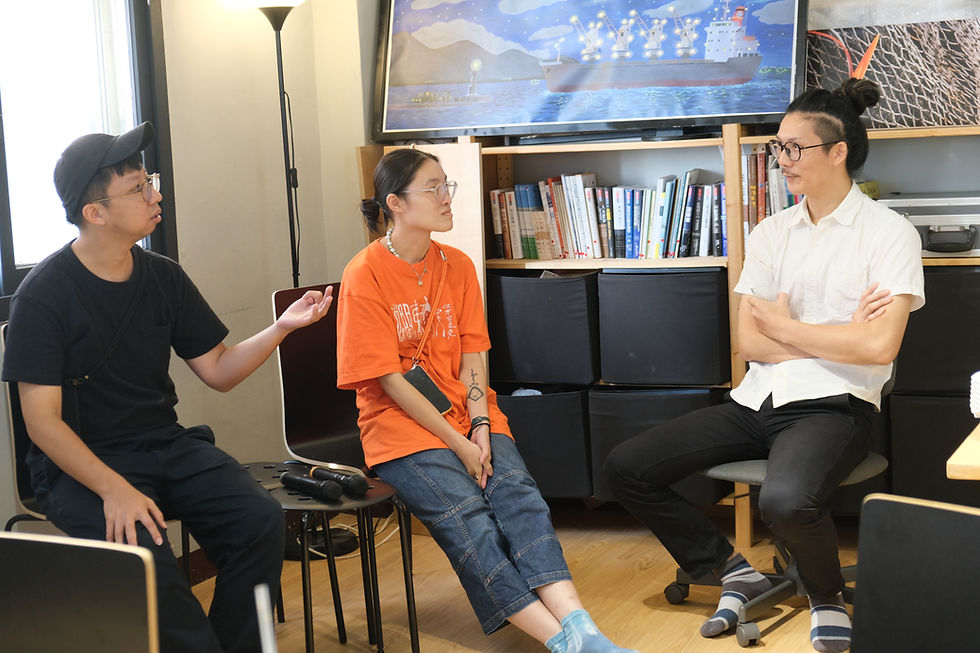海想知道|移動中的公共空間-Public Spaces on the Move
- 星濱山 ZhengbinArt

- 2021年4月12日
- 讀畢需時 7 分鐘
已更新:2024年3月26日
原文收錄於《海想知道》Vol.2 「昨日 X 今日 空間對話」
This article was originally published in Ocean Knows: Vol.2 "Past X Present Dialogue on Space"
打從小時候起,我便一直著迷於高速公路還有我們旅遊的方式。高速公路與 ‘verzorgingsplaatsen’(*註:「高速公路休息站」的荷蘭文)是由一堆瀝青、路標、以及線條拼湊在一起,且它們通常都不是終點,而是一趟旅程中的停留點。我喜歡這些場所,因為它們是民主的、包容的、極為個人,且有時極為隱匿的。當我開始探究基隆港的屬性時,我發現人們在使用這些空間的方式上,有著共同且不易被察覺的特徵。這篇文章將會試圖呈現這些共同特性。
Since I was young I always had a fascination for the highway and the way we travel. Highways and ‘verzorgingsplaatsen’ are cobbled together with asphalt, road signs, lines and are usually not a final destination, but a stop during a journey. I appreciate these places because they are democratic, inclusive, super personal, and at the same time super anonymous. While diving into the characteristics of Keelung Port, I discovered similar hidden qualities in the way we use these kinds of spaces. This article is the first step towards representing these similarities.

向高速公路學習
“On the move”是一個策略性的研究計畫,它以介入的方式探索‘verzorgingsplaatsen’(休息站、服務站、加油站)的隱藏特性。我的策略是去讀取以及學習這些高速公路系統:它們在過去以及今天是如何被使用?它們如何運作?它們發展出了什麼樣的視覺語言,又有什麼樣的基本規則——換句話說,該如何使用它們?在重層的運作中,是否有的功能已經被消除,如果有,那又是什麼?而未來的發展又會如何在視覺、空間使用、路線規劃等層面上影響‘verzorgingsplaatsen’?
高速公路一直都在與時俱進,回應著時代的需求以及現代科技的發展。當作為主要燃料的汽油消失之後,高速公路和那些連接的空間(‘verzorgingsplaatsen’)會發生什麼樣的變化?而我們對於那些地方的經驗又會如何改變?綜合考量在移動性、燃料、零售、還有政府層面上的各種發展,我認知到,我們需要好好思索這些高速公路和與其相似空間的未來,例如基隆港。
Learning from the Highway
“On the Move” is a strategic design and research project that explores ‘verzorgingsplaatsen’ (rest places, service- and gas stations) by interventions as an investigation on its hidden qualities. My strategy is a way to read and learn from the highway system; How have they been used in the past and how are they used today; the way they function, the visual language they have developed, the general protocol of gas stations, i.e. how to use them? Are there layers of use that have been erased and if so, which? How will future developments affect the ‘verzorgingsplaatsen’ in visual terms, the use of space and routing?
The highway is always up to date with present-day needs and modern technology. What will happen to the highway and therefore also to the connected spaces (‘verzorgingsplaatsen’), when gasoline disappears as the main fuel? And how does our experience of these places change? In combination with the developments that are taking place in mobility, fuel, retail and governmental, I feel a deep need to speculate on the future of the highway or similar spaces, such as Keelung Port.
向基隆港學習
基隆港乘載商業用途的大型運輸,同時也是由水路到市中心的一個過渡區域,而這個空間是帶有公共性質的。而我們能從這樣的空間學到什麼呢?我們如何能暫時地佔據這些空間?我們平時又會使用周遭什麼樣的材料、元素、和物件呢?這些物件的生命週期為何,而當我們不再需要它們時,又會發生什麼事呢?在空間以及功能性的層面上,這些變數該如何被未來的使用者詮釋,並且轉化成新的東西呢?
作為一個運輸的場所,科技與創新對於基隆港的建築圖像有很大的影響,尤其是對那些巨大的灰色公共空間。與此同時,基隆港也因為暫時性的人為使用和自然/氣候的影響而歷經轉化,而這些因素都影響著我們對基隆港的日常體驗。
基隆港和高速公路這兩個空間一開始都是為了規範與調節運輸產業而設計,但在隨時間流逝,在這些空間中,對於人與人互動的需求漸增。我們該如何把這種關乎「人」的議題帶入這些灰色的運輸環境裡,並且創造兼具包容性與個人詮釋性的新空間?一個相關的問題也同時需要被注意:在這樣的工業框架下,我們該如何創造一個更綠能、更健康、更居住友善的環境呢?在這之中,我們該如何考慮對於氣候的適應力,而諸如雨、樹木、植披等元素又該如何成為未來設計與建築發展的起點?
Learning from Keelung Port
Keelung Port is used for large-scale transportation, and at the same time, it functions as a transition zone from the waterway to the city center, used for commercial purposes where the quality of public space is leaking. So, what can we learn from these kinds of spaces? How do we occupy them temporarily and what kind of materials, elements, or objects do we use around us every day? What lifespan do they have and what will happen when we no longer need it? How can this be interpreted by future users, both spatially and functionally and develop into something new?
Keelung Port, a place of transport where technology and innovation have a major influence on the architectural image of those large grey public spaces. At the same time, it’s a place that is transforming by temporary human use and the impact of nature due to climate effects, influencing our daily experience.
Both locations, Keelung Port and the highway, are spaces originally designed out of regulations and restrictions for the transport industry, but in which the demand for human interaction/scale increased over the years. How can we integrate this human question within this grey, transport environment, where new spaces will be created for inclusivity and personal interpretation? At the same time the parallel question arises; how do we create a greener, healthier, and liveable environment in this industrial context? Where does climate adaptation play a role and where should elements such as rain, trees, and planting be the starting point for further design and architectural development?

那些等待被訴說的故事
這些隱身在運輸產業裡的空間是「沒有名字的公共空間」——我們不住在這些空間裡,但我們會短時間的佔據它們。比起這些場所過去與未來的使用者,它現下的使用者獲得的是很不一樣的價值。因此,這些場所是不斷地在產出新的故事的。這些場所的歷史根深蒂固於其故事的基礎中,且舊的故事會延展至那些新的,確保人們可以與場所產生連結。暫時性的設計與建築性的介入可以是揭露這些故事的一個工具,而這能提供使用者一個新的視野,使他們得以與場所創造新的故事線與連結。因著日新月異的科技,基隆港與高速公路的發展一直都在變動中,而它們的使用者也會繼續適應這些持續變動的公共場所。這類「沒有名字的公共空間」永遠不會揭示一個最終的結局,它永遠都會是個開頭....
Stories to be Told
Hidden spaces such as in the transport industry are unnamed public spaces; spaces we don’t live in but occupy for a short period of time. This makes that a place offers different values for present users compared to previous and future users. Therefore, the place is constantly creating new stories. The history of the place is the fundamental and fixed part of the story, and the old one is extended with the temporary stories, ensuring that people are able to connect to a place. Temporary design and architectural interventions can be a tool for revealing those histories and gives the user a new perspective for creating new storylines and relationships with the place. The development of Keelung Port and the highway is always on the move due to the technology and innovation and the users will keep adapting to the constantly changing public space. These kinds of unnamed public spaces never show a final result, it’s continuously the beginning…

* 還想知道更多關於基隆的故事嗎? >> 點我即可線上購買《海想知道》,收藏更多關於土地與創作的書寫!
* 實體購買《海想知道》Vol.1 & Vol.2,
可以至 >>
基隆|星濱選品客廳、小獸書屋、見書店、金豆咖啡、圖們 咖啡公寓 台北|田園城市生活風格書店、恬野書、有河書店、大稻埕青鳥居所 新北|方寸書店、靠北過日子 桃園|新星巷弄書屋 苗栗|日榮本屋 南投|籃城書房、山里好巷、貿易風書旅 彰化|好好生活書店、紅絲線 text apartment 台南|曬書店 高雄|三餘書店 屏東|紅氣球、小島停琉 花蓮|孩好書屋、雨樵懶人書店 台東|晃晃書店、在海一方獨立書店

文|Janneke Derksen
圖|Janneke Derksen、康宥儒
Janneke Derksen
策略式景觀設計師/ “On the move” 計畫設計師/NoPurpose Collective創辦人
專長分析與研究,並從中創造出得以公開地處理設計問題的框架。她同時扮演著在公共領域媒合人與知識的策略性角色。
strategic landscape designer/ designer of the project “On the move”/ founder of NoPurpose Collective
Her focus is on analysis and research, in which she creates a framework to approach the design question openly. She is a strategic player who brings people and knowledge together in the public domain.
#基隆港 #Keelungport #公共空間 #Publicspace #高速公路 #Highway #verzorgingsplaatsen’








留言